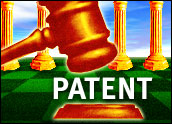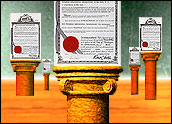
On October 14, 2010, the Federal Court of Canada handed down its much-anticipated decision regarding Amazon’s patent application for an invention entitled “Method and System for Placing a Purchase Order Via a Communication Network,” or what has more colloquially been referred to as the “Amazon 1-Click Patent.”
While the Federal Court did not explicitly grant the issuance of the Canadian application, contrary to the request made by Amazon, the application has been remanded for re-examination on an expedited basis. This Canadian decision comes on the heels of the controversial four- year re-examination by the United States Patent and Trademark Office, which led to the eventual successful upholding of the Amazon 1-Click Patent (US 5,960,411).
The Amazon 1-Click Patent has been the subject of much criticism and debate since it was originally filed in the United States back in 1997. Critics expressed concerns with the breadth of the patent protection applied for, as well as the protection that was subsequently granted. Others expressed concerns over the subject matter itself, and whether the largely software-implemented single click, or 1-click, method allowing an online shopper to trigger a payment for services or goods was in fact patentable subject matter. This latter concern was at the root of the Canadian prosecution.
Canadian Prosecution
The underlying Canadian patent application itself was filed on September 1998 and claimed priority from the aforementioned U.S. filing. After a prolonged prosecution period before the Canadian Intellectual Property Office, the application was denied in 2004 by the Commissioner of Patents citing section 2 of the Canadian Patent Act. Specifically, the Amazon 1-Click application, which sought protection for what has been termed a “business method,” was denied for not being patentable subject matter under the Patent Act.
Amazon appealed that decision before a Patent Review Panel, and that process was additionally delayed in view of the retirement of two members of the panel. Eventually, the panel generated a report that upheld the original ruling.
Amazon subsequently appealed that decision to the Canadian Federal Court. In overturning the underlying decision, Justice Phelan drew a distinction between a tangible new business method and business schemes or disembodied ideas. Those with “no practical embodiment …, like any other abstract idea or theorem, will of course be non-patentable.” Further, Justice Phelan stated that the Amazon 1-Click invention was a “practical application” implemented “through the use of cookies, computers, the Internet and the customer’s own action.”
As previously intimated, the decision of Phelan J. itself is carefully worded. Specifically, the Court “allows the appeal with respect to the Commissioner’s findings on statutory subject-matter” and “the Commissioner’s decision is quashed and is sent back for expedited re-examination with the direction that the claims constitute patentable subject matter to be assessed in a manner consistent with these Reasons.”
US Re-examination
In the USPTO, the Amazon 1-Click patent faced an ex parte re-examination itself, triggered in 2006 when New Zealand actor Peter Calveley requested the re-examination. Calveley has blog devoted to his experience with the re-examination process, and he is a staunch critic of the present post-grant opposition procedures.
“The fact that ‘one click shopping’ is obvious from a common-sense viewpoint was what caused the public outcry in the first place,” he wrote in a recent post, “so one would think the USPTO would want to conduct a serious examination of this aspect rather than essentially ignoring it as they did.”
Despite Calveley’s personal views regarding the obviousness of the 1-Click Patent, his successful re-examination application was essentially based upon two main groups of prior art not previously addressed by the USPTO:
- “ON-LINE SECURED FINANCIAL TRANSACTION SYSTEM THROUGH ELECTRONIC MEDIA” (US 5,729,594); and
- an excerpt of an article written by Stephen Levy — a good summary of which comes from Steven Levy’s “The End of Money?” Newsweek pp. 62-65 October 30 1995:
“You’re cruising the net, hopping from link to link with your favorite browser. In a small window in the corner of your screen sits a ledger. ‘$100.00. As you land on a favorite web site, something strikes your fancy — an annotated bibliography of every article ever written about Sandra Bullock! Only five bucks. You click on a button, and the file is downloaded to your computer. That tiny ledger on your screen now reads ‘$95.00.'”
Based upon those two families of prior art, the USPTO forced Amazon to amend claims 1-5 and claims 11-26 of its 1-Click Patent.
Impact of Decision in Canada
While the decision itself has a direct impact for Amazon, it too addresses an uncertainty or ambiguity in Canadian patent law practice regarding the patentability of business methods themselves. In reviewing the decision of the Commissioner, Justice Phelan states that “there is no basis for the Commissioner’s assumption that there is a tradition of excluding business methods from patentability in Canada.”
Justice Phelan continues by reiterating an excerpt of the Canadian Manual of Patent Office Procedure wherein business methods are “not automatically excluded from patentability, since there is not authority in the Patent Act or the Rules or in the jurisprudence to sanction or preclude the patentability based on their inclusion in this category.”
In closing, Justice Phelan explicitly states that “there is no exclusion for ‘business methods’ which are otherwise patentable, nor is there a ‘technological’ test in Canadian jurisprudence.” As an aside — but perhaps more telling of the impact of this decision — there is the fact that Justice Phelan refers to this matter as a “test case” to assess the Canadian patent practice policy “rather than an application of the law to the patent at issue.”
C. Donald Brown is an intellectual property lawyer atHeydary Hamilton. Brown’s practice includes patents, trademarks, copyrights and industrial designs, as well as IT matters.











































Social Media
See all Social Media